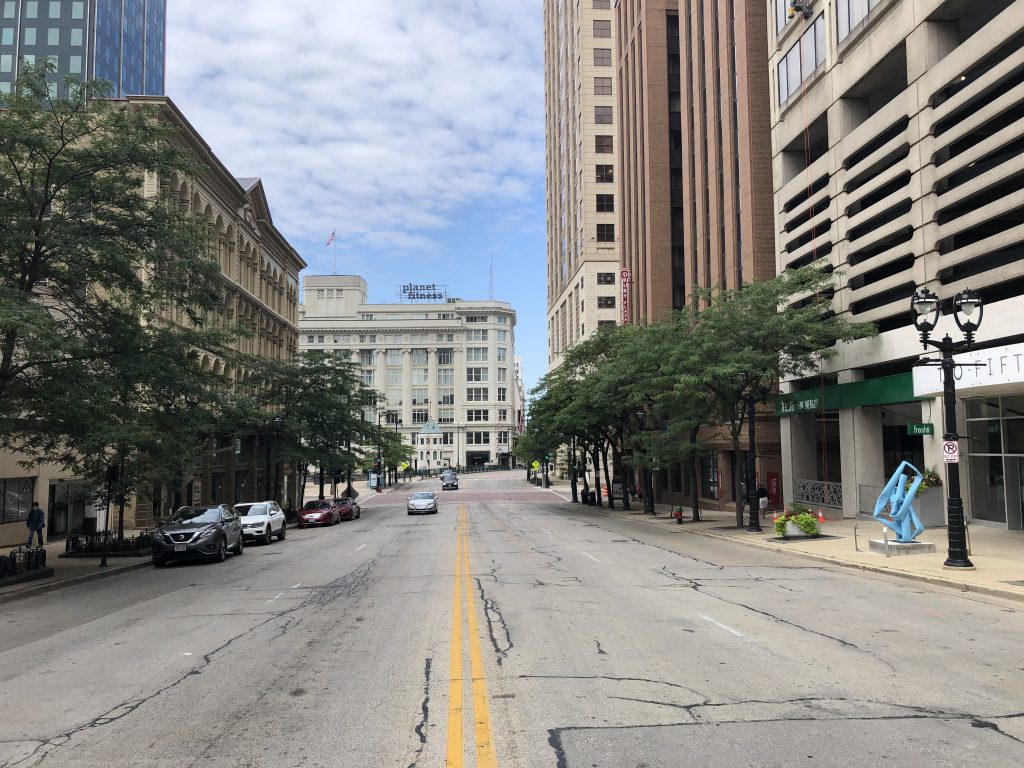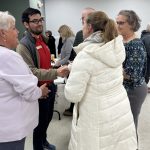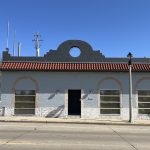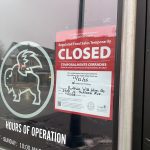City Can Do More to Plant Trees
Too much concrete in Downtown and other areas. City codes must change, developers should spend more.
I read Bruce Murphy’s recent UM column on Milwaukee’s urban forestry celebrating how well we’re doing relative to other metropolitan areas. As this topic has been a seed between my teeth for many years, I felt compelled to provide a further perspective.
There is so much more that we could be doing – both public and private sector – to nurture and advance our urban tree canopy. A lack of green-sensitive development standards in our zoning code lends to an uneven buildout of the public right of way when new development occurs. Too often developers build ‘wall-to-wall’ and then, without consideration for the sidewalk experience, pour continuous concrete slabs from building line to curb line as a finishing touch. How can this be allowed? It results in an absolutely brutal public realm, one that precludes expansion of an urban forestry that enhances a pedestrian-centric urban experience.
The reasons for lack of promotion of a greener streetscape are well known. From the city’s perspective, hollow sidewalks, steam tunnels, utility interferences and management of leaves are practical concerns of our public works department. There have even been criteria established discouraging trees, suggesting you need a lot more absorptive infrastructure to sustain them. To that concern I give you Exhibit 1: the trees along the now-Drury Hotel that have survived and thrived despite the scant absorptive area that supports them.
How spectacular would Wisconsin Avenue and other downtown streets look with trees like these lining the pedestrian realm?
From the private developer’s perspective, the reason against installing landscaping is simple – it costs more than concrete. It costs more to install and maintain landscaping as compared to concrete – a lot more. The ongoing maintenance takes time, patience, and money. The propensity to argue “urban design” as a means of using every square foot of property for a building’s footprint – can’t we show just a bit more imagination and creativity?
Compare this relatively quiet yet heavily landscaped frontage of Corcoran Lofts (Disclosure: the project was developed by Mandel Group, which I work for) in the Third Ward with other new development. This wasn’t hard to do but does require time and investment to maintain. Dogs from throughout the Third Ward find it a very desirable destination for their walks regardless of their home address! It is noticeably cooler walking along street frontages like this due to the impact of landscape elements and shading they provide. Regardless of the tightness of building to sidewalk, it’s a completely pleasant experience.

The North End (Disclosure: the project was also developed by Mandel Group) – early May 2021. Photo courtesy of Robert Monnat.
And trees don’t need to be included to the disadvantage of street-level retail space. The old argument “they’ll block the view of my business and signage” – oh please, wake up!
Suburban communities are well known to establish rigorous landscape installation and landscape maintenance standards integral to the development approvals they issue. Urban communities throughout Milwaukee would be well served to consider similar guidance to encourage complementary additions to our urban forestry as new developments come forward for approval.
Living in the city should not mean having to sacrifice the living elements that enhance our urban environment. Murphy’s analysis suggests we’re doing better than others; let’s expand on that by ensuring that new additions to our urban streetscapes contribute in a positive way by incorporating meaningful landscape elements and treescapes.
Robert Monnat, Senior Partner at Mandel Group.
Op-Ed
-
Wisconsin Candidates Decry Money in Politics, Plan to Raise Tons of It
 Dec 15th, 2025 by Ruth Conniff
Dec 15th, 2025 by Ruth Conniff
-
Trump Left Contraceptives to Rot; Women Pay the Price
 Dec 8th, 2025 by Dr. Shefaali Sharma
Dec 8th, 2025 by Dr. Shefaali Sharma
-
Why the Common Council’s Amended Budget is Good Policy for Milwaukee
 Nov 20th, 2025 by Alds. Marina Dimitrijevic and Russell W. Stamper, II
Nov 20th, 2025 by Alds. Marina Dimitrijevic and Russell W. Stamper, II























Kudos to Bob Monnat for speaking out in favor of the importance of trees and other green, growing things in urban developments in Milwaukee! The Mandel Group is one of the few developers in our area that consistently gives serious attention to including green spaces in their projects. This is so important for dealing with stormwater, helping to reduce sewer overflows and basement backups, improving our air quality, and reducing the urban heat island effect. But it also makes great sense for improving the quality of life of those who live in these developments or visit them as customers. Ultimately, it increases the value of the developments, and the tax base of the City. The City has been far too slow to update its codes and development practices to 21st Century needs.
I totally agree with Bob Monnat that more integrated green space within the urban environment makes us more attractive, more environmentally friendly, healthier, and more competitive. I also agree that codes are critical to making this happen.